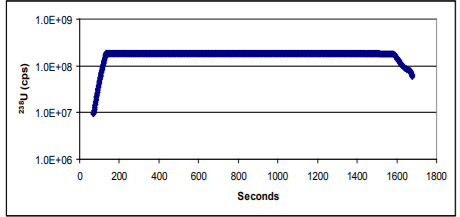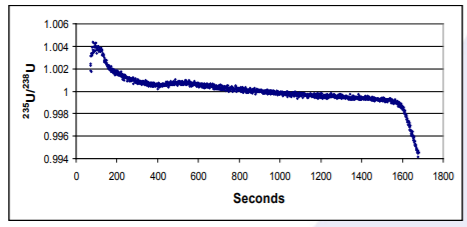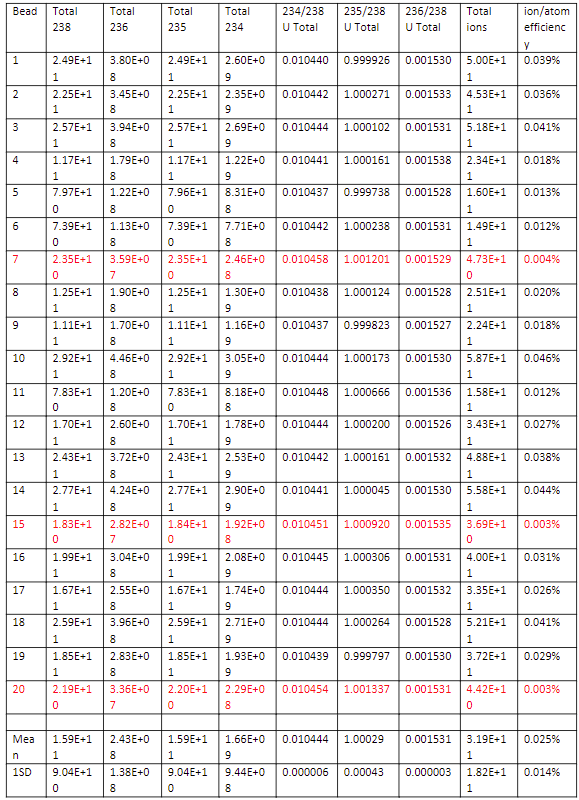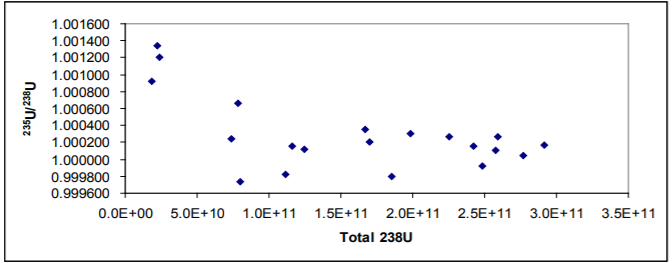Zenon Palacz, Isotopx Ltd, Middlewich, Cheshire, UK
Introduction
Uranium does not have a stable isotope pair that can be used to correct for mass fractionation in a TIMS. Measurements have to be made using external mass fractionation control or by total evaporation of the sample and simultaneous (static) collection of all isotopes.
Addition of a doubly enriched isotope spike e.g. 233U and 236U can be used to correct for mass fractionation, but mixed, enriched isotopes are expensive and not practical for the majority of uranium analysts.
Here we report the results of uranium measurements on the equal atom SRM U500 standard using a total evaporation (TE) procedure on a Phoenix TIMS instrument.
Experimental
500ng of U500 was loaded onto one side filament of a triple rhenium filament assembly. 20 filaments were placed into the sample magazine of a Phoenix TIMS instrument and data collected for all 20 filaments.
The source vacuum was <5e-8 mbar during the analyses and the analyser was <4e-9 mbar. Samples were heated automatically and a Rhenium ion beam of 80mv was attained. The evaporation filament current was then increased and a 238U ion beam of 200mv was optimized.
At this point the evaporation filament current was increased until an aiming intensity of 2 volts 238U was reached. This intensity was maintained throughout the analysis by increasing or decreasing the evaporation filament current.
The measurement was terminated when the ion beam dropped below 500mv and the side filament went to 4A. A sustainable ion beam of 2 volts can be produced for approximately 25 minutes (Figure 1).
Baselines were taken for 30 seconds at +/-0.5amu at the end of the focus stage with a 238U ion beam of 200mv.

No corrections for peak tails were made. Data was taken with 1 second integration throughout the analysis. Where each 1 second integration comprised 10 , 100 millisecond data packets. The ion intensity and the filament current adjustment was made every 100 milliseconds.
Results
The results are shown in Table 1. The first 4 columns are the summed intensities in cps for each of the isotopes detected during the evaporation. The ratio columns are the ratios of the summed intensities at the end of the evaporation.
The total number of atoms in a 500ng load of Uranium is ~1.27e15. The mean number of ions detected was 3.2e11 which yields an ion/atom efficiency of 0.025%. There were 3 filaments (No.’s 7, 15 and 20) with poor efficiency (<0.004%) and these skew the mean. Removing these yields a mean efficiency of 0.03% (17 from 20).
There is considerable scatter in the efficiency data which may be related to the temperature of the ionizing filament. Further work will address this. The highest efficiency obtained was 0.046%.
As expected the 235U/238U continuously changes during the evaporation process, but it changes more rapidly at the start and at the end of the analysis (Figure 2).

Figure 3 shows that the 3 low efficiency filaments were hardly fractionated and had higher 235U/238U. Removing these 3 points (Table 2) results in 235U/238U of 1.000138+/- 0.022% 1RSD (17 out of 20). This is higher than the certificate value but identical to double spike measurements (1.000195+/-0.000078 2RSD) in Condon et. al 2010.
The minor isotope ratios are slightly higher than the certificate, but this could be due to baselines being measured at low ion intensity, with no correction for abundance sensitivity.



Uranium Sensitivity of Phoenix. These data show that the Phoenix TIMS has an efficiency of 0.03% for large 500ng loads of uranium using a triple rhenium filament assembly. This does not include ions used during the warp-up process which account for <5% of the total ion beam.
Burger et. al (2009) evaluated the ionization efficiency of small uranium samples using different loading techniques. The Saha-Langmuir equation calculates the ion yield from a filament based on the work function of the filament and the ionization potential of the sample. For uranium with a rhenium filament, the best efficiency is between 0.1% and 0.25% (this does not take into account losses within the spectrometer). The efficiency increases to 1-2% with the addition of carbon to the filament or as much as 10% loading as a point source such as a resin bead.
Efficiency increases significantly as sample size decreases (Edwards et. al 1986) and the measurements described in the preceding paragraph were made with nanogram or picogram loads of uranium compared to the 500ng loads in this study. Burger et. al indicate that for loads with no carbon, TIMS efficiencies are 0.01% to 0.001%. Presumably with the lowest efficiencies being for larger loads. The ionization efficiency of U on Phoenix is significantly higher and within a factor of 3-6 of the ideal case predicted by the Saha-Langmuir equation. The Phoenix efficiency is the same as a high efficiency cavity source with a small sample and carbon activation (Burger et. Al 2009).
Summary
- Total evaporation measurements of NBSU500 reproduce 235U/238U to 0.02% 1RSD.
- The 235U/238U is 1.00014+/-0.00023 (0.02% 1RSD), comparable with double spike fractionation corrected data.
- Ion atom efficiency for 500ng Uranium is 0.03% using triple filaments with no carbon additive.
References
- R. Lawrence Edwards, J.H. Chen and G.J. Wasserburg. Earth and Planetary Science Letters, Vol. 81 (1986/87) 175-192
- S. Burger, L.R. Riciputi , D.A. Bostick, S. Turgeon1, E.H. McBay, M. Lavelle., Int. Journal. of Mass Spectrometry, 2009, Vol. 286, P. 70-82.
- Daniel J. Condon, Noah McLean, Stephen R. Noble and Samuel A. Bowring. Geochimica et Cosmochimica Acta, Vol.74, Issue 24, 15 December 2010, Pages 7127-7143
Download Application Note
Download the complete Application Note: TE of 500ng loads of U500 using Phoenix